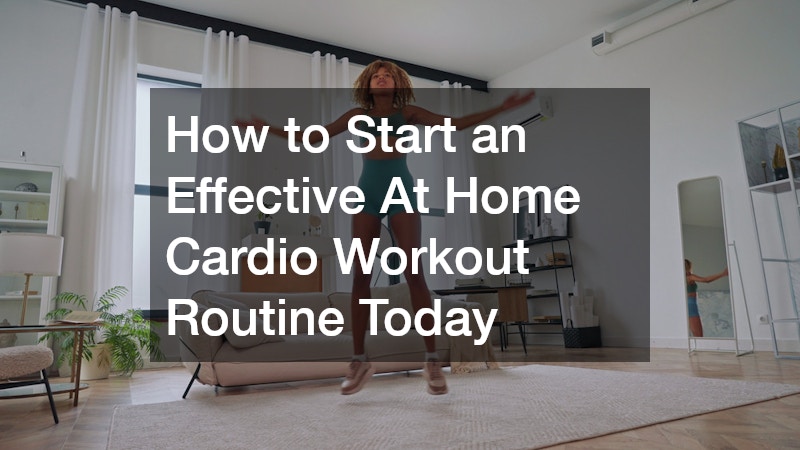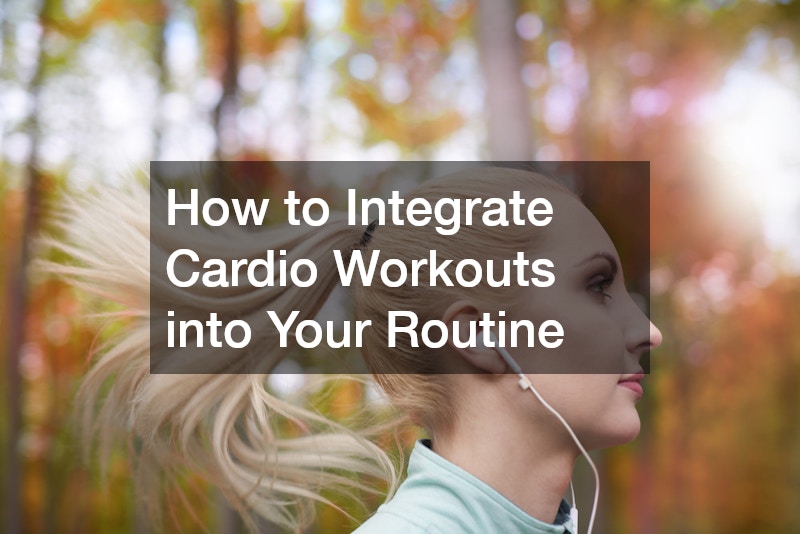
Starting a new fitness routine can feel overwhelming, especially when you’re doing it from home. But cardio workouts don’t require a fancy gym or expensive equipment to be effective. With a bit of planning and consistency, you can build an at home cardio workout routine that boosts your heart health, burns calories, and improves your overall wellness—all from the comfort of your living room.
This guide will walk you through everything you need to know to create a sustainable, safe, and effective at-home cardio program that fits your lifestyle.
Why Choose Cardio Workouts at Home?
Cardio, short for cardiovascular exercise, targets your heart and lungs, improving endurance, burning fat, and supporting overall health. But why should you do it at home?
Working out at home offers a long list of benefits:
- Convenience: No travel time or gym fees
- Flexibility: Exercise on your schedule
- Privacy: No gym anxiety or waiting for machines
- Affordability: Minimal to no equipment required
Whether you’re a busy professional, a stay-at-home parent, or just prefer a private setting, home cardio can be just as effective as hitting the treadmill at the gym.
What are the Benefits of At-Home Cardio Workouts?
Before we dive into the “how,” let’s explore why you should even consider adding cardio to your home fitness routine. Here are the top health benefits:
- Heart Health: Improves circulation and lowers the risk of heart disease.
- Weight Management: Burns calories and supports fat loss.
- Mood Boosting: Releases endorphins, reducing stress and anxiety.
- Endurance Building: Enhances stamina and daily energy.
- Immune Support: Moderate cardio helps improve immune function.
Regular cardio workouts can also help manage blood sugar, cholesterol, and blood pressure levels—all critical factors in long-term health.
What Should You Know Before Starting?
Before jumping into a new fitness routine, take a moment to assess your starting point. Here are a few questions to ask yourself:
- Do you have any existing injuries or medical conditions?
If yes, consult a healthcare professional before starting. - What’s your current fitness level?
Beginners should focus on low-impact routines and gradually build intensity. - What’s your goal?
Whether it’s weight loss, better endurance, or heart health, knowing your goal helps design the right program.
Also, be sure to have:
- Comfortable workout clothes and shoes
- A safe, clutter-free space to move
- A water bottle nearby for hydration
How to Structure an Effective At-Home Cardio Workout Routine

A well-designed workout includes more than just random jumping jacks. You need structure, progression, and consistency. Here’s how to build your routine:
1. Warm-Up (5-10 minutes)
Start every session with a gentle warm-up to prepare your body and reduce injury risk.
Examples:
- Arm circles
- Marching in place
- Shoulder rolls
- Dynamic stretches (e.g., toe touches, hip openers)
2. Main Cardio Session (15-30 minutes)
This is the core of your workout, where you increase your heart rate and burn calories.
Types of cardio you can do at home:
- High knees
- Jumping jacks
- Burpees
- Mountain climbers
- Skaters
- Shadow boxing
You can structure your routine using one of these formats:
- Interval Training: Alternate between high-intensity and low-intensity periods.
- Circuit Training: Perform a series of exercises back-to-back with minimal rest.
- Steady-State Cardio: Maintain moderate intensity throughout.
3. Cool-Down and Stretch (5-10 minutes)
Help your heart rate return to normal and prevent stiffness with a cool-down phase.
Cool-down exercises:
- Gentle walking in place
- Deep breathing
- Static stretching (hamstrings, quads, calves, shoulders)
What Are Some Beginner-Friendly Cardio Workouts?
If you’re just starting out, keep it simple. Focus on low-impact, easy-to-follow moves that gradually build stamina and confidence.
Sample 20-Minute Beginner Cardio Workout:
| Time | Exercise |
| 2 mins | March in place |
| 2 mins | Step side-to-side |
| 2 mins | Arm swings and shoulder rolls |
| 3 mins | Jumping jacks (or half jacks for low impact) |
| 3 mins | High knees (march or jog) |
| 2 mins | Squat to standing |
| 2 mins | Side lunges |
| 2 mins | Step touch with arm reach |
| 2 mins | Cool down and stretch |
Tips for beginners:
- Modify movements to your fitness level.
- Take short breaks as needed.
- Focus on form, not speed.
- Aim for 3-4 sessions per week to start.
How Often Should You Do Cardio at Home?
- Staying consistent with your cardio routine is essential if you want to see real improvements in your fitness. Health experts generally advise aiming for around 150 minutes of moderate cardio each week, such as a brisk walk or low-impact aerobic sessions. If you prefer more intense activity, 75 minutes of high-intensity cardio like HIIT workouts, jumping rope, or running can also be effective.
- To make this manageable, consider breaking your workouts into 3 to 5 sessions per week, depending on your schedule and fitness level. Always include at least one full rest day to help your body recover and avoid overtraining. For a more well-rounded approach, try pairing your cardio with strength training two or three times a week. This combination supports fat loss, builds muscle, and enhances overall health.
Equipment vs. No Equipment: What Works Best?
You can get an amazing cardio workout without any equipment. But a few tools can help increase intensity and variety.
No Equipment Needed:
- Jumping jacks
- Mountain climbers
- Burpees
- Running stairs
- Dance workouts
Optional Equipment:
- Jump rope: Great for quick, high-intensity cardio.
- Resistance bands: Add muscle engagement to cardio moves.
- Dumbbells: Incorporate light weights for cardio-strength fusion.
- Step platform: Adds intensity and coordination challenges.
Choose what works for your budget, space, and goals. Even bodyweight cardio alone can deliver powerful results when done consistently.
How to Stay Motivated at Home?
Sticking to a workout routine at home can be challenging without a coach or class to hold you accountable. Try these motivation hacks:
- Set SMART Goals (Specific, Measurable, Achievable, Relevant, Time-bound)
- Track Your Progress using a journal or fitness app
- Join a Virtual Workout Group for community and support
- Create a Playlist of high-energy music
- Reward Yourself when you reach milestones
Also, remember that not every day will be perfect. The key is to keep showing up.
Common Mistakes to Avoid When Starting At Home Cardio
It’s easy to make missteps early on that lead to injury or burnout. Avoid these pitfalls:
- Skipping Warm-Ups or Cool-Downs
Always take time to prepare and recover. - Doing Too Much, Too Soon
Increase intensity gradually to avoid overtraining. - Not Listening to Your Body
Rest when needed and modify moves if you feel pain. - Lack of Variety
Repeating the same routine can lead to boredom and plateaus. Mix it up! - Poor Form
Watch tutorials or use a mirror to ensure proper technique.
Sample Weekly At Home Cardio Workout Plan
Here’s a basic 5-day weekly plan to help you get started and stay on track.
| Day | Workout |
| Monday | 20-Min Beginner Cardio (Low-Impact) |
| Tuesday | HIIT (High-Intensity Intervals, 25 mins) |
| Wednesday | Rest or light walking |
| Thursday | Dance cardio or kickboxing (30 mins) |
| Friday | Circuit Training (Bodyweight, 30 mins) |
| Saturday | Optional: Outdoor jog, cycling, or fun activity |
| Sunday | Rest and recovery (stretching or yoga) |
How to Measure Success Without a Scale?
Progress isn’t just about pounds lost. Other non-scale indicators of success include:
- Increased stamina (you can go longer without getting winded)
- Lower resting heart rate
- More energy throughout the day
- Improved mood and better sleep
- Clothes fitting differently
- More confidence and consistency
Take progress photos, track your workouts, and celebrate small wins along the way.
What Are the Best At Home Cardio Exercises for Small Spaces?
Don’t let limited space stop you from getting your heart rate up. There are plenty of effective cardio moves that require only a few feet of room and no equipment.
Here are the top choices for small-space cardio:
- High Knees in Place – Run in place with exaggerated knee lifts to increase heart rate.
- Jumping Jacks – A classic full-body movement that requires only vertical space.
- Mountain Climbers – Great for cardio and core strength, done in a plank position.
- Skaters – Side-to-side leaps that mimic a skating motion and work your legs.
- Burpees (Modified if Needed) – A total-body move that burns calories fast.
These exercises are ideal for apartments, dorm rooms, or small home gyms. Just make sure the area is clear of clutter and has a non-slip surface.
How to Incorporate Variety in Your At Home Cardio Routine
Repeating the same workout every day can quickly lead to boredom or fitness plateaus. To keep your body challenged and your motivation high, variety is essential.
Here’s how to mix things up:
- Alternate Workout Styles – Combine HIIT, dance cardio, steady-state, and bodyweight circuits throughout the week.
- Use Themed Days – For example, “Boxing Mondays,” “Tabata Tuesdays,” and “Low-Impact Fridays.”
- Switch Up Your Music – Curate playlists with different vibes (pop, EDM, 90s hits) to refresh the energy.
- Rotate Equipment – If you have bands, weights, or a jump rope, alternate their use to target different muscles.
- Try Online Classes – Platforms like YouTube or fitness apps offer endless free workout videos to follow.
Incorporating variety keeps your body adapting and makes your workouts more enjoyable.
How to Track Progress with Your Cardio Routine at Home

Monitoring your progress is a great way to stay motivated and measure your success, even if you’re not focused on weight loss. There are multiple ways to track improvement without relying solely on a scale.
Try these tracking methods:
- Keep a Workout Journal – Note down exercises, duration, and how you felt after each session.
- Track Your Heart Rate – Use a smartwatch or fitness tracker to monitor how your cardiovascular endurance improves.
- Record Milestones – Did you move from 20 minutes to 30? Complete a full HIIT workout without stopping? Celebrate it!
- Take Progress Photos – Visual comparisons over time can highlight changes you may not see day to day.
- Use Fitness Apps – Apps like MyFitnessPal, Fitbit, or Apple Health can log sessions, set goals, and generate insights.
Progress tracking helps you see how far you’ve come and motivates you to keep going.
Your Roadmap to an Effective At Home Cardio Workout Routine
Now that you have all the tools and knowledge, the next step is action. Remember:
- Start where you are—modify as needed
- Set achievable goals
- Stick to a schedule
- Choose workouts that you enjoy
- Don’t be afraid to try new formats (dance, intervals, step, etc.)
- Celebrate every milestone
With commitment and consistency, your at home cardio routine can deliver results that rival any gym session—without ever leaving your front door.


